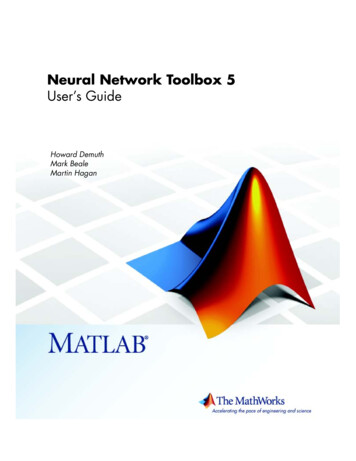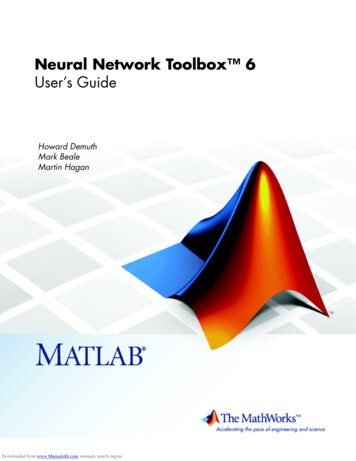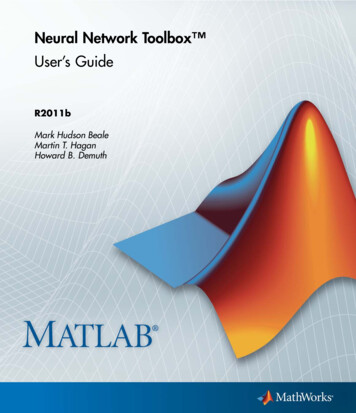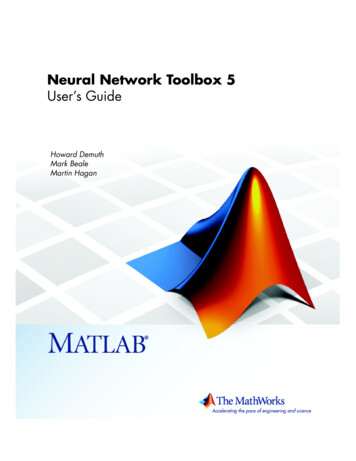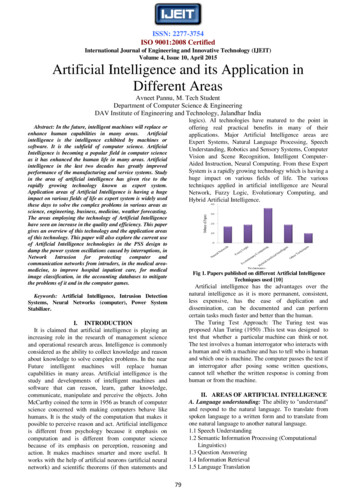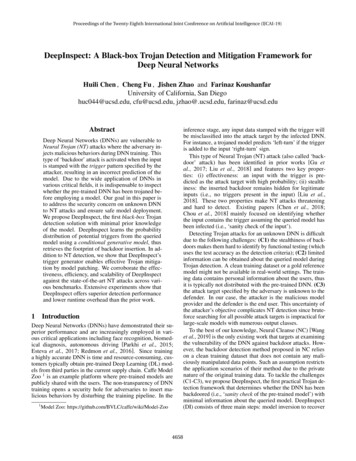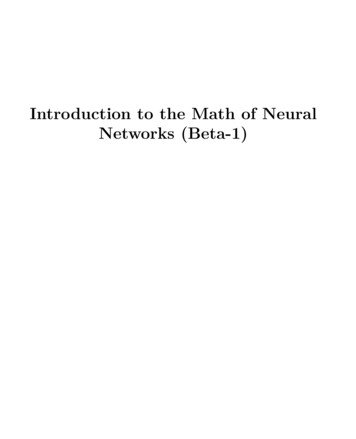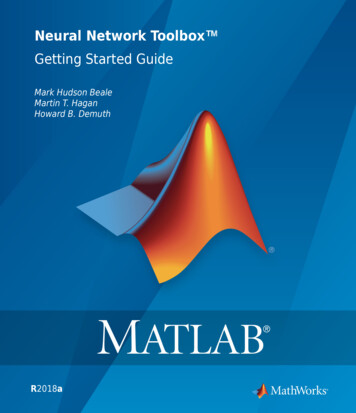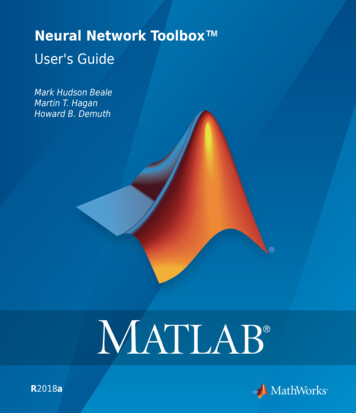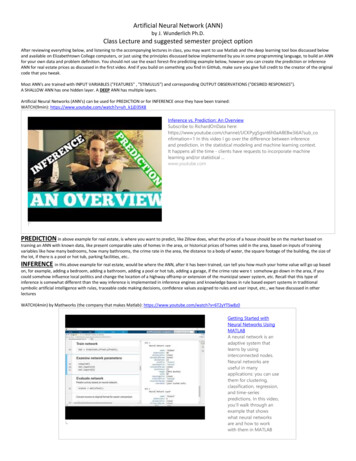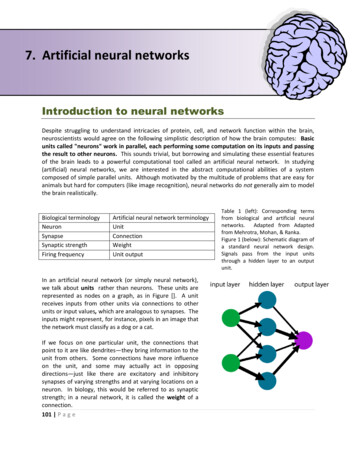
Transcription
7. Artificial neural networksIntroduction to neural networksDespite struggling to understand intricacies of protein, cell, and network function within the brain,neuroscientists would agree on the following simplistic description of how the brain computes: Basicunits called "neurons" work in parallel, each performing some computation on its inputs and passingthe result to other neurons. This sounds trivial, but borrowing and simulating these essential featuresof the brain leads to a powerful computational tool called an artificial neural network. In studying(artificial) neural networks, we are interested in the abstract computational abilities of a systemcomposed of simple parallel units. Although motivated by the multitude of problems that are easy foranimals but hard for computers (like image recognition), neural networks do not generally aim to modelthe brain realistically.Biological terminologyNeuronSynapseSynaptic strengthFiring frequencyArtificial neural network terminologyUnitConnectionWeightUnit outputIn an artificial neural network (or simply neural network),we talk about units rather than neurons. These units arerepresented as nodes on a graph, as in Figure []. A unitreceives inputs from other units via connections to otherunits or input values, which are analogous to synapses. Theinputs might represent, for instance, pixels in an image thatthe network must classify as a dog or a cat.If we focus on one particular unit, the connections thatpoint to it are like dendrites—they bring information to theunit from others. Some connections have more influenceon the unit, and some may actually act in opposingdirections—just like there are excitatory and inhibitorysynapses of varying strengths and at varying locations on aneuron. In biology, this would be referred to as synapticstrength; in a neural network, it is called the weight of aconnection.101 P a g eTable 1 (left): Corresponding termsfrom biological and artificial neuralnetworks.Adapted from Adaptedfrom Mehrotra, Mohan, & Ranka.Figure 1 (below): Schematic diagram ofa standard neural network design.Signals pass from the input unitsthrough a hidden layer to an outputunit.
The connections pointing away from a unit are like its axon—they project the result of its computationto other units. This output is analogous to the firing rate of a neuron. The neural networks we will studywork on an arbitrary timescale and do not “fire action potentials,” although some types of neuralnetworks do.There are many types of neural networks, specialized for various applications. Some have only a singlelayer of units connected to input values; others include “hidden” layers of units between the input andfinal output, as shown in Figure 1. If there are multiple layers, they may connect only from one layer tothe next (called a feed-forward network), or there may be feedback connections from higher levels backto lower ones, as we see in cortex.Neural networks can “learn” in several ways: Supervised learning is when example input-output pairs are given and the network tries toagree with these examples (for instance, classifying coins based on weight and diameter, givenlabeled measurements of pennies, nickels, dimes, and quarters) Reinforcement learning is when no “correct” answer is given along with the input data, but thenetwork’s performance is “graded” (for instance, it might win or lose a game of chess) Unsupervised learning is when only input data are given to the network, and it finds patternswithout receiving direct feedback (for instance, recognizing that there are four types of coinswithout assigning the labels “penny,” “nickel,” “dime,” “quarter”)We will focus on supervised learning. They can also perform “association” tasks, for instancereproducing a full image from a small piece.The learning problemIf you show a picture to a three-year-old and ask him if there is a tree in it, he is likely to give you theright answer. If you ask a thirty-year-old what the definition of a tree is, he is likely to give you aninconclusive answer. We didn't learn what a tree is by studying the mathematical definition of trees. Welearned it by looking at a lot of trees. In other words, we learned from data.Yaser Abu-MostafaNeural networks are most commonly used to “learn” an unknown function. For instance, say you wantto classify email messages as spam or real. The ideal function is one that always agrees with you, butyou can’t describe exactly what criteria you use. Instead, you use that ideal function—your ownjudgment—on a randomly selected set of messages from the past few months to generate trainingexamples. Each training example is simply an email message with a correct label, either “spam” or“real.”You decide to automatically classify the message based on how many times each word on a list appears.You will multiply each frequency by some value, add up these products, and if they exceed somethreshold, the message will be labeled spam. Your strategy provides you with a set of candidate rules(corresponding to the possible multipliers and thresholds) for deciding whether a message is spam.Learning then consists of using the training examples to pick the best rule from this set. (There might be102 P a g e
better ideas, for instance taking into account grammar or the sender’s email address, but we aren’tconcerned with those during the formal process of learning.)Once you come up with a rule, its performance is evaluated on a test set. The test set is essentially aspare training set: it consists of inputs (in this case emails) with correct labels (“spam” or “real”). Youuse your rule to classify the inputs in the test set and compare the results to the correct labels to seehow you did. This is a crucial step that allows us to estimate how well our rule will do when we startusing it on our email. Because we have specifically worked to make our rule agree with the trainingexamples, its performance on those training examples is artificially inflated. Your rule may performslightly better or worse on the test set than on emails in general, but at least this estimate of itsperformance is unbiased. In order to draw meaningful conclusions from the test set, we need to becareful not to contaminate it by using it to select a rule. If our rule doesn’t do well on the test set andwe go back to adjust it, we need to use a new test set.You can think of training examples as last year’s exam that you study from, and the test set as the actualexam your teacher gives. Making sure you can do all of last year’s problems should improve your grade,but being able to do all of the practice problems (after seeing the answers!) doesn’t mean you’vemastered the subject. And if you do poorly on the exam and your teacher lets you retake it, youshouldn’t get the same questions again!It may seem strange that we can learn a completely unknown function with any confidence. The key isthat the training and testing examples are selected randomly from the same population of inputs wecare about being able to process correctly. Using laws of probability, we can put an upper bound on thechance that the “out-of-sample” (non-training) error will be very different from the “in-sample”(training) error.Linear threshold unitsThe rule we described for classifying emails was actually a computation that could be performed by a“artificial neuron” called a linear threshold unit (LTU), shown in Figure 2.x0 -1x1x2x3 xn103 P a g ew0w1w2LTUw3 swnf(s)
An LTUreceivesscalar inputss w0 x0 w1 x1 w2 x2 x0 , x1 , x2 ,, xnand first wn xn . (We could also write this ascomputes thei n w xi 0i iweighted sumor the dot product w x .)If s 0 , then the LTU outputs f(s) 1; otherwise, it outputs f(s) -1. This is known as a “hardthreshold” and represents a decision about or classification of the input data. Many neural networks usea soft thresholding function, in which the output is always between -1 and 1 but does not “jump” fromone to the other.The input x0 is special; it is always 1 . This effectively implements a nonzero threshold for theweighted sum of the actual inputs. At the boundary between the neuron outputting -1 and 1, s 0 , sow0 x0 w1 x1 w2 x2 wn xn 0 w0 w1 x1 w2 x2 wn xn 0w1 x1 w2 x2 wn xn w0The special weight w0 is often called the LTU’s threshold. The plane of values ( x1 , x2 , x3 ,, xn ) thatleads to s 0 is called the decision boundary because on one side the LTU outputs 1 and on the otherside it outputs -1.An important consequence of using the weighted sum s is that an LTU can only learn to distinguishbetween sets that are indeed separated by some plane, as shown in Figure 3.Figure 3: A single LTUcould distinguish betweencircles and triangles only inthe case on the left. In theother two examples, thereis no line dividing the twogroups.Let’s do an example computation of an LTU’s output. Here is a unit that receives two inputs besides x0 :-13150LTU-1sf(s)In this case, s 3 ( 1) 1 5 ( 1) 0 2 , which is positive, so f ( s) 1 . The decision boundary isshown in Figure 4.x2104 P a g e
f (s) 1Figure 5: Decision boundary for the LTU shown inFigure 4. To find the boundary we set s 0 , so 3 ( 1) 1 x1 ( 1) x2 0 f ( s) 1 x1x1 x2 3Check a few points, such as (5,0) as shown in theexample in Figure 4, to check that the decisions shownon this plot agree with the output of the LTU.In class, we will study the perceptron learning rule, which provides a way to adjust the weights of an LTUbased on a training set. As long as it is possible for an LTU to distinguish between the input classes, theperceptron learning rule will eventually find a correct decision boundary.Storing memories in a neural networkBesides learning unknown functions, neural networks can also be used to associate an input pattern (forinstance, an incomplete or corrupted version of an image) with a stored “memory.” This is a commonproblem in everyday life: we associate people’s names with their faces and other characteristics, forinstance, and can often call up a complete song (“by the dawn’s early light”) or story (“and he puffedand he blew the house down!”) from just a few notes or words. Children practice their animal sounds(“What does the dinosaur say?”) before they even have experience with the animals.We will study one of the most commonly used implementations of “memory” in an artificial neuralnetwork, a discrete Hopfield network. This network is made up of connected linear threshold units (theoutput of one becomes the input to another) whose output can be either -1 or 1 at any given time. Amemory then corresponds to a state of the network, meaning the current output of each unit. Onenatural type of memory for a discrete Hopfield network is a binary image, in which each pixel (a unit) iseither white (output 1) or black (output -1).-111-1-1-1105 P a g eFigure 6: A small discrete Hopfieldnetwork (left) and the image its staterepresents (right). The current outputof each unit is represented by itscolor, black (-1) or white (1). Forclarity, connections between the unitsare either -1 (black arrows) or 1(white arrows).
Units are updated one at a time in random order until the state of the network stops changing. Theinput to a Hopfield network is the initial pattern, and the output is this stable (unchanging) state.As an example, consider updating the bottom right node in Figure 6: The weighted sum of the inputs is 1( 1) 1(1) 1( 1) 1(1) 1( 1) 5 , which is positive, so the output should change to 1. Should anyof the other outputs change?- ---In class we will learn how to choose the weights to ensure that one or more images are stable states ofthe network. Then when an input (initial image) is presented, the network will proceed to the mostsimilar stored image. We will only consider Hopfield networks with symmetric weights, meaning thatthe weight from unit A to unit B is the same as the weight from unit B to unit A.Chapter resourcesVocabularyUnitWeightSupervised learningReinforcement learningUnsupervised learningTraining examplesTest setLearningLinear threshold unit (LTU)Decision boundaryThresholdHopfield networkStable state106 P a g e
LAB 7: Human linear thresholdunitsTraining a PerceptronYou will be working in pairs to train linear threshold units to recognize colors using the Perceptronlearning rule (taught in class).1. Choose one partner to start as the LTU, and one to start as the trainer (you’ll switch). Obtain arule card for the trainer. The trainer will know the actual rule the LTU should implement andwill say whether the LTU’s output is correct or incorrect after each training example.2. The trainer should split the pile of example cards into a training set ( 2/3) and a test set ( 1/3).Set the test set aside.3. Go through the entire training deck twice, shuffling the cards in between. For each card,a. The trainer looks at the color and makes a decision based on his/her rule regarding whatthe output of the LTU should be (1 or -1). For instance, if the rule card says “This colorlooks either red or green” and the color looks purple, the output should be -1. Thetrainer does NOT show the color to the LTU.b. The trainer reads the input values to the LTU. The first input value is always -1 toimplement a possibly nonzero threshold, as discussed in the reading. The remainingthree inputs are red, green, and blue light intensities.c. The LTU computes the weighted sum s based on the current weights (initially all zero).If s is nonnegative, the output is 1; otherwise the output is -1.d. The trainer tells the LTU whether the output was correct or not. If the output wasincorrect, the LTU needs to increment the weights by 0.1 y x , where y is the correctoutput and the vector x is the input pattern. In this case the learning rate is 0.1.The LTU should keep track of the computations for each input in the tables provided.4. Put aside the training deck and move to the test deck. Now the weights of the LTU are set andwill no longer vary—we just want to see how well it agrees with the rule on examples it’s neverseen before.5. Finally, the trainer can tell the LTU what the “true” or “target” rule was. Then switch roles witha fresh rule card.107 P a g e
TRAININGInputWeights(-1,(0, 0, 0, 0)sOutputCorrect?Change weights by 108 P a g e
TESTINGFinal weights:Input109 P a g esOutputCorrect?
Human Hopfield networkIn this part we will go outside to simulate the function of a Hopfield network with two stored images.The weights for the network have already been computed, and you will be exploring the behavior of thenetwork to discover the stable states.Each student will act as one unit or “pixel” in an image. You have a piece of posterboard which can beplaced white-side-up to signal output 1 or black-side-up to signal output -1. Along with yourposterboard will be instructions on how to update your pixel.1) Start with the initial pattern that has been set up and find one stable state by allowing the“neurons” to repeatedly update their values until no one needs to change his/her output valueanymore. Record the input and output patterns.2) Repeat the process of finding a stable state from a different initial pattern the instructors will setup. Record the input and output patterns.3) Explore which input patterns map to which outputs:a. Start from one of the stable states and have only one student flip his/her posterboard,then proceed to update until you reach a stable state.b. Start from one of the stable states and have four students flip their posterboards. Doyou still reach the same state? What if you choose another four students?c. Start from one of the stable states and have ALL of the students flip their posterboards.110 P a g e
Human LTU homeworkPart A: Perceptrons1) What was the first rule your LTU tried to learn?a) Summarize its performance on the training set by plotting the fraction of correct decisionsagainst the training example number (group five examples together).b) How well did it do on the test set (percentage correct)?c) Did it “learn” the secret rule? How might you have improved its performance?2) What was the second rule your LTU tried to learn?a) Summarize its performance on the training set by plotting the fraction of correct decisionsagainst the training example number (group five examples together). It turns out this one wasimpossible for a single LTU to compute. Do you have evidence that it wasn’t able to learn thisrule?b) Draw a neural network made up of multiple LTUs that could learn this second rule. You maydescribe what each unit computes in words rather than giving exact weights.Part B: Hopfield network3) Prove that if a state of a Hopfield network is stable, so is its “inverse” (with the output of each unitflipped from 1 to -1 or vice versa).4) How accurate would you guess your classmates were in their arithmetic? Why could we reach astable state without requiring that none of 24 students would make a mistake during the updates?111 P a g e
In an artificial neural network (or simply neural network), we talk about units rather than neurons. These units are represented as nodes on a graph, as in Figure []. A unit receives inputs from other units via connections to other units or input values, which are analogous to synapses. T
